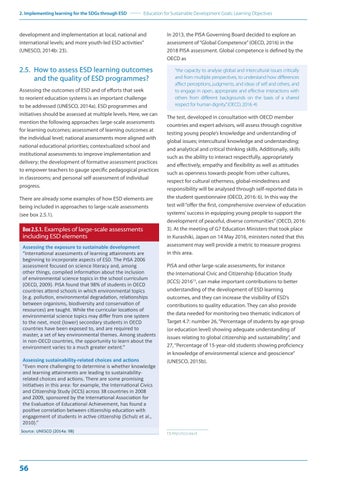2. Implementing learning for the SDGs through ESD
Education for Sustainable Development Goals: Learning Objectives
development and implementation at local, national and international levels; and more youth-led ESD activities” (UNESCO, 2014b: 23).
2.5. How to assess ESD learning outcomes and the quality of ESD programmes? Assessing the outcomes of ESD and of efforts that seek to reorient education systems is an important challenge to be addressed (UNESCO, 2014a). ESD programmes and initiatives should be assessed at multiple levels. Here, we can mention the following approaches: large-scale assessments for learning outcomes; assessment of learning outcomes at the individual level; national assessments more aligned with national educational priorities; contextualized school and institutional assessments to improve implementation and delivery; the development of formative assessment practices to empower teachers to gauge specific pedagogical practices in classrooms; and personal self-assessment of individual progress. There are already some examples of how ESD elements are being included in approaches to large-scale assessments (see box 2.5.1).
Box 2.5.1. Examples of large-scale assessments including ESD elements Assessing the exposure to sustainable development “International assessments of learning attainments are beginning to incorporate aspects of ESD. The PISA 2006 assessment focused on science literacy and, among other things, compiled information about the inclusion of environmental science topics in the school curriculum (OECD, 2009). PISA found that 98% of students in OECD countries attend schools in which environmental topics (e.g. pollution, environmental degradation, relationships between organisms, biodiversity and conservation of resources) are taught. While the curricular locations of environmental science topics may differ from one system to the next, most (lower) secondary students in OECD countries have been exposed to, and are required to master, a set of key environmental themes. Among students in non-OECD countries, the opportunity to learn about the environment varies to a much greater extent.” Assessing sustainability-related choices and actions “Even more challenging to determine is whether knowledge and learning attainments are leading to sustainabilityrelated choices and actions. There are some promising initiatives in this area: for example, the International Civics and Citizenship Study (ICCS) across 38 countries in 2008 and 2009, sponsored by the International Association for the Evaluation of Educational Achievement, has found a positive correlation between citizenship education with engagement of students in active citizenship (Schulz et al., 2010).” Source: UNESCO (2014a: 98)
56
In 2013, the PISA Governing Board decided to explore an assessment of “Global Competence” (OECD, 2016) in the 2018 PISA assessment. Global competence is defined by the OECD as “the capacity to analyse global and intercultural issues critically and from multiple perspectives, to understand how differences affect perceptions, judgments, and ideas of self and others, and to engage in open, appropriate and effective interactions with others from different backgrounds on the basis of a shared respect for human dignity.” (OECD, 2016: 4)
The test, developed in consultation with OECD member countries and expert advisors, will assess through cognitive testing young people’s knowledge and understanding of global issues; intercultural knowledge and understanding; and analytical and critical thinking skills. Additionally, skills such as the ability to interact respectfully, appropriately and effectively, empathy and flexibility as well as attitudes such as openness towards people from other cultures, respect for cultural otherness, global-mindedness and responsibility will be analysed through self-reported data in the student questionnaire (OECD, 2016: 6). In this way the test will “offer the first, comprehensive overview of education systems’ success in equipping young people to support the development of peaceful, diverse communities” (OECD, 2016: 3). At the meeting of G7 Education Ministers that took place in Kurashiki, Japan on 14 May 2016, ministers noted that this assessment may well provide a metric to measure progress in this area. PISA and other large-scale assessments, for instance the International Civic and Citizenship Education Study (ICCS) 201615, can make important contributions to better understanding of the development of ESD learning outcomes, and they can increase the visibility of ESD’s contributions to quality education. They can also provide the data needed for monitoring two thematic indicators of Target 4.7: number 26, “Percentage of students by age group (or education level) showing adequate understanding of issues relating to global citizenship and sustainability”, and 27, “Percentage of 15-year-old students showing proficiency in knowledge of environmental science and geoscience” (UNESCO, 2015b).
15. http://iccs.iea.nl


